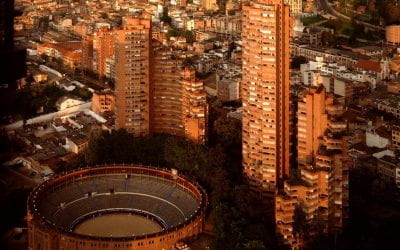A Practice in Full
An Audience with Oscar Niemeyer
Oscar Niemeyer’s gaze reveals nothing as the ten of us make our way through the throng of architecture students towards the rows of seats that fan out from his facing central chair. Loosely clasped on his lap, his gnarled hands almost seem sculpted from the strong abutments that form the escarpment of this seaside city of Rio de Janeiro, Brazil. The thought of the works they have touched and of the history that they have helped shape make them appear more powerful than they really are. I could not help thinking about the pencils they have held, of the magnificent drawings that they have guided. He has worked and created so much for so long that he has outlived his contemporaries, both practitioners and critics. One might say that he has outlived his own context.
The now 102-year-old Niemeyer is best known for his involvement in Brasilia, the capital city carved out of brush nearly 400 miles from the nearest paved road. He was asked to participate in this project by the then-president, Juscelino Kubitschek, a populist president (not unlike today’s president, Luis Inácio Lula da Silva, who is taking an active role with the planned 2016 Olympics). Niemeyer created most of the important buildings in Brasilia, working in concert with his old boss and frequent collaborator, Lucio Costa, who laid out the master plan. He completed many of his greatest works in this former capital city, but the ambitious conceit of Brasilia, some critics charged, often overshadowed the works themselves. Let us hope that Lula has learned this lesson well as the initial planning for the Olympics begins.
We ten Loeb Fellows, ‘09, from Harvard’s Graduate School of Design, traveled to Brazil to study megacities and the effects these huge metropoli have on natural resources and social structures. We are climate change activists, photographers, philanthropic program managers, green building consultants, after school innovators, developers, artists, historic preservationists, planners and architects. Among us, there are Niemeyer admirers, skeptics, and provocateurs—we are a diverse group.
Although he may now be considered the last of the living modernists, Niemeyer has never been considered a pure modernist. He does not and has never obeyed the dictates of modernism or postmodernism (or any of the other “isms” for that matter). It may be closer to the truth to say that he never was in vogue, then or now. He has always been an outlier, preferring his own convictions to the leanings of any group. Niemeyer values the notion of harmony between nature and building; he values human interactions within his works. Perhaps most telling, he increasingly references love itself as the essence of what architecture must be to have meaning. The world’s leading architects, on the other hand, often prefer obtuse philosophical arguments to such simple ones.
While walking Rio’s busy streets a day earlier, we had found ourselves in front of the powerful and balanced Ministry of Education and Health, on which Niemeyer collaborated with many of the aspiring Cariocan architects of the time. The New York Times described it in 1943 as “the most advanced architectural structure in the world.” Indeed, it is still one of the best examples of passive design in a large structure, with its intelligent overhangs, operable shading devices, and numerous operable windows. It is a building that today’s green architects would do well to emulate. In stark contrast to the groundbreaking work exhibited in the MEH, the Museum of Contemporary Art of Niterói, finished by Niemeyer’s team in 1996, seems an ode to Niemeyer’s past triumphs. While its quiet but commanding presence exhibits the architects unceasing talent for artistry, the project looks backward rather than forward. It was within this conflicting framework that our group found its way to our seats .
In the course of our audience, a member of our group asked Niemeyer how his buildings respond to the need to educate the public about the dangers of dwindling resources. He responded “This is not my job description. I concern myself with architecture. I am not a politician.” Indeed, he has long stated his goal in architecture is to create “surprise and enchantment.” He creates beauty in an age when it is not always valued without an accompanying manifesto. It is no wonder his fellow modernists never really embraced him. Oscar Niemeyer has always had the courage to run alone.
Spring | Summer 2010, Volume IX, Number 2
James Brown was a 2008-09 Loeb Fellow at the Harvard University Graduate School of Design. He is Principal of Public Architecture and Planning in San Diego, California.
Related Articles
Architecture: Editor’s Letter
For years, readers have been commenting on the printed edition of ReVista: “How beautiful!” Now here’s a website to match, thanks to the efforts of the design firm 2communiqué and Kit Barron of DRCLAS. It’s not only a question of reflecting the aesthetics of the printed…
Working in the Antipodes
I was asked by ReVista to write an article on my own work, specifically about the fact that I do simultaneous work on social housing and high-profile architectural projects, something that is, to…
Three Tall Buildings
I used to hate the three tall towers that thrust against the verdant mountains. I used to think that the red brick towers dug into the landscape, belonging to some other city and some other space, created a scar of modernity…





